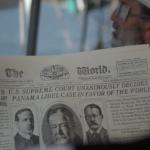Business of Art | The Artist as Advocate: Three Savvy Ways to Champion a Cause
With a bit of resolve and tenacity, it is possible to make change.
Each year, The New York Foundation for the Arts (NYFA) participates in American for the Arts’ National Arts Action Summit along with over 85 national partner organizations and artists. The event, which includes Arts Advocacy Day, presents a chance to dive deep into the state of the arts and fine-tune skills for arts advocacy across local, state, and national levels. Advocates gather during this time to meet with their Members of Congress to garner support for issues like funding for the National Endowment for the Arts (NEA), arts education policy, and strengthening support for creative entrepreneurs through the CREATE Act.*
Mirielle Clifford, who attended the National Arts Action Summit on behalf of NYFA, is sharing a few takeaways for individual artists on how to advocate for the issues they care about. After engaging in dialogue with legislative staffers and joining together with a cross-section of arts administrators to mobilize support for the arts, Clifford has one overriding message: with a bit of resolve and tenacity, it is possible to make change if you advocate for it.
*The “CREATE Act,” or the Comprehensive Resources for Entrepreneurs in the Arts to Transform the Economy (CREATE) Act, includes a critical clarification to ensure that federal emergency relief funds (FEMA) will be made available to artists and self-employed or freelance entrepreneurs for replacement of tools following a disaster.
Get in Touch and Build a Relationship
Your interactions with your elected officials need not begin and end with your ballot on election day. There are more potential lines of communication between you and your representative than you may think. As a start, Americans for the Arts provides an Advocacy Toolkit that will help you connect with your U.S. Congressperson and their team and build awareness in your community. One of your first points of action is to visit your elected official’s “Contact” page on their website. A U.S. Congressperson, for example, will have at least one office in their district and one in Washington, D.C. The “Contact” page will include several other ways of getting in touch, via phone or email, and you can often make an appearance request or request a meeting. There will most likely be a caveat that not all requests can be filled, but this doesn’t mean you shouldn’t try, and try again. Several elected officials offer regular opportunities to meet in the form of events like “Constituent Coffees.”
Subscribe to your representative’s newsletter, and follow them on social media. Their social media platforms are a great way to learn about their stances on issues you care about, stay up-to-date with legislation they champion, and get updates around events where they will be present. An in-person event may be a chance to introduce yourself to your elected official or a member of their team.
Whatever the means of communication, be sure to communicate with courtesy and respect, but pack a punch with the three magic words: “I’m a constituent.” Elected officials tend to prioritize the perspectives of people who live in their districts or states. During an in-person visit or conversation, ask for a card for that individual or for an appropriate member of their team so you can stay in touch, and follow up promptly, with an e-mail and a written thank you note. Then, do a periodic follow-up. You may be surprised. After months of not receiving a response from a busy legislative staffer, for example, a strategically written follow-up may elicit an immediate response. In all of your communications, be sure to show appreciation, and thank the staffer for their time.

Make a Strong Case. Rinse. Repeat
Once you’ve made contact, capitalize on that connection by making a strong case. First, do your research. Much of the legislative work in Congress for example, takes place in Congressional Committees which are often divided into Subcommittees. Knowing which Committees and Subcommittees your representative serves on will help, as they may be able to provide more in-depth support for a piece of legislation depending on their committee placement. Whatever their position, you can often ask them to co-sponsor a bill, join the Congressional Arts Caucus, or support arts funding.
In any conversation with an elected official or member of their team, try to make an impression. Share a unique detail about your work in the district or your personal experiences with the arts, and tell a story about the issue you’re advocating about. Randy Cohen, Vice President of Research and Policy at Americans for the Arts, abides by the “golden rule” of arts advocacy: “No numbers without a story; no story without numbers.” Quantify how many people in your district will benefit from a project or piece of legislation, and specify who those people are and why this issue is important to them, using compelling, specific, and personalized examples.
A strong arts and culture infrastructure is a priceless asset to any community, but it’s often critical to portray the economic incentives behind your issue. And this should be easy to do. A recent NEA report shows that the arts and culture sector surpassed agriculture and transportation in contributing to the American economy. In 2015, the arts contributed more than $760 Billion to the U.S. economy as a whole. The benefits of this economic engine can be traced to your town, county, and state through these “Creative Industries” Reports. Once you’ve made your case, follow up!
Remember, You’re an Expert
You may not be an economist, but you’re impacted by the health of the local and national economy. You may not be a medical practitioner or public health expert, but you need healthcare. You may not be a “lobbyist” by title, but you belong in the halls of Congress, at City Hall, and at your State Capitol as much as anyone else.
Bring your community with you in the stories you tell, especially since there may be many who can not advocate for themselves as constituents. Use your concrete advocacy skills to shine a light on the issues that affect your community, from immigration to affordable housing, and work towards solutions. Build your strength in numbers by partnering with other individuals who agree with you about what’s at stake, and get involved with organizations who are working towards solutions for your community.
– Mirielle Clifford, Program Officer, Online Resources
To read more articles about the topics that impact you as an artist, visit the Business of Art section of NYFA’s website. Sign up for NYFA News and receive artist resources and upcoming events straight to your inbox.
Images: The U.S. Capitol Building and Rayburn House Office Building, March 2019, Photo Credit: Mirielle Clifford for NYFA





